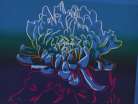
Kiku (F. & S. II.307)

Kiku (F. & S. II.307)
Signed Print
Andy Warhol
£11,500-£17,000
$23,000-$35,000 Value Indicator
$21,000-$30,000 Value Indicator
¥110,000-¥160,000 Value Indicator
€13,000-€19,000 Value Indicator
$120,000-$180,000 Value Indicator
¥2,390,000-¥3,530,000 Value Indicator
$15,000-$23,000 Value Indicator
There aren't enough data points on this work for a comprehensive result. Please speak to a specialist by making an enquiry.
50 x 65cm, Edition of 300, Screenprint
Auction Results

Track auction value trend
Meaning & Analysis
Kiku (F. & S. II.307) is a screen print from Andy Warhol’s Kiku series (1983). Warhol’s career-long fascination with flowers prompted Fujio Watanuki, the founder of the Gendai Hanga Centre in Tokyo, to commission the series based on the motif of the Japanese flower,chrysanthemum (‘kiku’ in Japanese). This print shows a delicate display of two overlapping chrysanthemums, one as a red outline and one rendered in bright blue, as symbols for Japanese imperial power, rendered in his classic aesthetic of colour-field patterning and precious multi-coloured silhouettes.
Kiku (F. & S. II.307) contrasts with Warhol’s earlier iterations of flower subjects as it exhibits a peaceful, elegant atmosphere and is created on a much smaller scale so as to adhere to conventional Japanese living spaces. As well as symbolising the Japanese Emperor, the chrysanthemum is representative of longevity, rejuvenation and the autumn season. This is reflected in Warhol’s harmonising colour choice of blue, yellow, orange and red and emphasis on hand drawn lines that overpower the photographic element of this piece.
First visiting Japan in 1956 whilst travelling around the world, Warhol returned for a second time in 1974 for a solo exhibition at the Daimaru Department Store. This series is indicative of Warhol’s global influence and that he was much admired by Japanese collectors and gallerists.